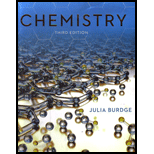
Interpretation:
The empirical formula of the compound is to be calculated.
Concept introduction:
The number of moles is defined as the ratio of mass to the molar mass:
Here,
Molar mass is calculated by adding the masses of each element multiplied by their number of atoms present (given in subscript). Its S.I. unit is
The mass of compound can be calculated as
Here,
the Mass of carbon can be calculated as
The mass of hydrogen can be calculated as
Answer to Problem 154AP
Solution: The empirical formula of the first compound is
Explanation of Solution
Given information:
For gasoline
For methyl tert-butyl ether
The molar mass of
Calculate the number of moles of water as
Substitute
The molar mass of
Calculate the number of moles of carbon dioxide as
Substitute
The molar mass of
For carbon in
Calculate the mass of carbon as
Substitute
The molar mass of
For hydrogen in
Calculate the mass of hydrogen as
Substitute
The mass of the given sample is
Calculate the mass of lead as
Substitute
Rearrange the above equation for
Now, the number of moles of each element is to be calculated as
The molar mass of
Calculate the number of moles of carbon as
Substitute
The molar mass of hydrogen is
Calculate the mass of hydrogen as
Substitute
The molar mass of lead is
Calculate the mass of lead as
Substitute
So, the molecular formula of the compound can be written as
As the empirical formula are always has whole number multiples, on simplifying the number of moles of each element, it is calculated as
For H
For C
For Pb
So, the empirical formula of the compound is
Now, for tert-butyl ether:
The molar mass of
Calculate the number of moles of water as
Substitute
The molar mass of
Calculate the number of moles of carbon dioxide as
Substitute
The molar mass of
For carbon in
Calculate the mass of carbon as
Substitute
The molar mass of
For hydrogen in
Calculate the mass of hydrogen as
Substitute
The mass of the given sample is
Calculate the mass of oxygen as
Substitute
Rearrange the above equation for
Now, the number of moles of each element is to be calculated as
The molar mass of carbon is
Calculate the mass of carbon as
Substitute
The molar mass of hydrogen is
Calculate the mass of hydrogen as
Substitute
The molar mass of oxygen is
Calculate the mass of oxygen as
Substitute
So, the molecular formula of the compound is
As the empirical formula are always whole number multiples, on simplifying the number of moles of each element, it is calculated as
For H
For C
For O
So, the empirical formula of the compound is
The empirical formula of the first compound is
Want to see more full solutions like this?
Chapter 3 Solutions
Chemistry
 ChemistryChemistryISBN:9781305957404Author:Steven S. Zumdahl, Susan A. Zumdahl, Donald J. DeCostePublisher:Cengage Learning
ChemistryChemistryISBN:9781305957404Author:Steven S. Zumdahl, Susan A. Zumdahl, Donald J. DeCostePublisher:Cengage Learning ChemistryChemistryISBN:9781259911156Author:Raymond Chang Dr., Jason Overby ProfessorPublisher:McGraw-Hill Education
ChemistryChemistryISBN:9781259911156Author:Raymond Chang Dr., Jason Overby ProfessorPublisher:McGraw-Hill Education Principles of Instrumental AnalysisChemistryISBN:9781305577213Author:Douglas A. Skoog, F. James Holler, Stanley R. CrouchPublisher:Cengage Learning
Principles of Instrumental AnalysisChemistryISBN:9781305577213Author:Douglas A. Skoog, F. James Holler, Stanley R. CrouchPublisher:Cengage Learning Organic ChemistryChemistryISBN:9780078021558Author:Janice Gorzynski Smith Dr.Publisher:McGraw-Hill Education
Organic ChemistryChemistryISBN:9780078021558Author:Janice Gorzynski Smith Dr.Publisher:McGraw-Hill Education Chemistry: Principles and ReactionsChemistryISBN:9781305079373Author:William L. Masterton, Cecile N. HurleyPublisher:Cengage Learning
Chemistry: Principles and ReactionsChemistryISBN:9781305079373Author:William L. Masterton, Cecile N. HurleyPublisher:Cengage Learning Elementary Principles of Chemical Processes, Bind...ChemistryISBN:9781118431221Author:Richard M. Felder, Ronald W. Rousseau, Lisa G. BullardPublisher:WILEY
Elementary Principles of Chemical Processes, Bind...ChemistryISBN:9781118431221Author:Richard M. Felder, Ronald W. Rousseau, Lisa G. BullardPublisher:WILEY





